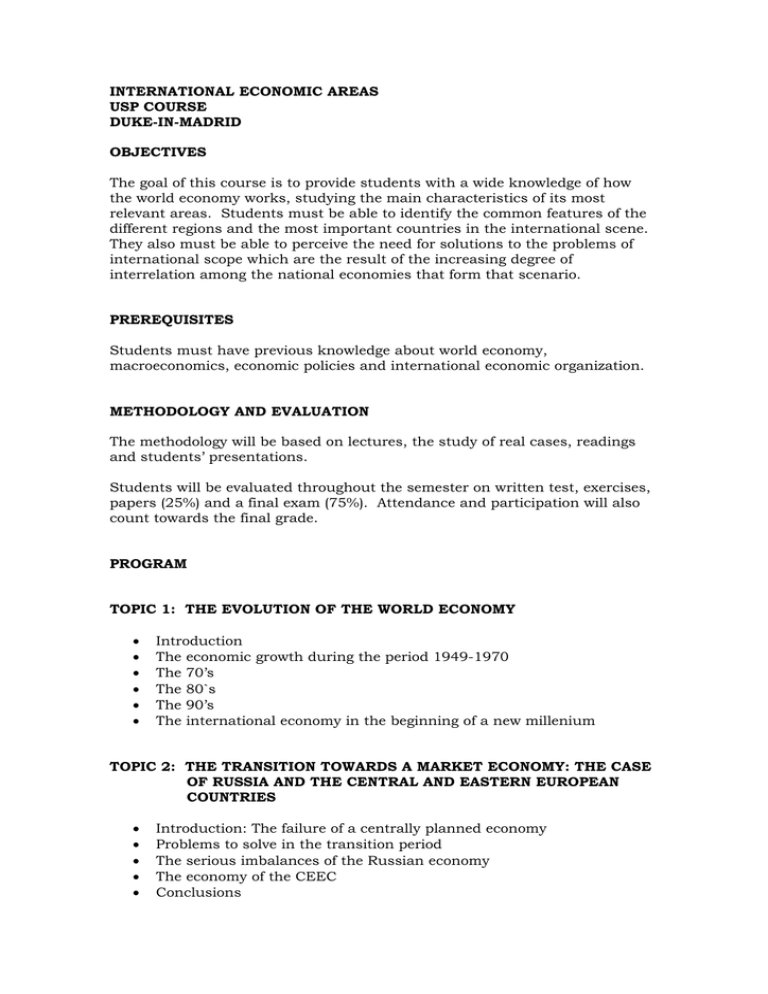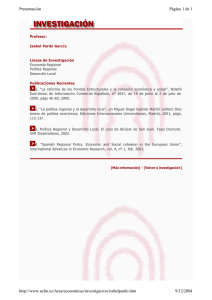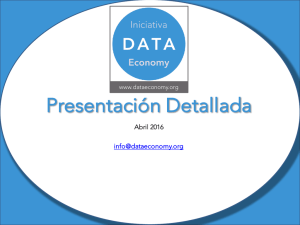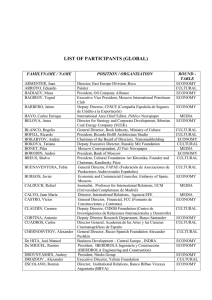THE ECONOMY OF THE EUROPEAN UNION
Anuncio

INTERNATIONAL ECONOMIC AREAS USP COURSE DUKE-IN-MADRID OBJECTIVES The goal of this course is to provide students with a wide knowledge of how the world economy works, studying the main characteristics of its most relevant areas. Students must be able to identify the common features of the different regions and the most important countries in the international scene. They also must be able to perceive the need for solutions to the problems of international scope which are the result of the increasing degree of interrelation among the national economies that form that scenario. PREREQUISITES Students must have previous knowledge about world economy, macroeconomics, economic policies and international economic organization. METHODOLOGY AND EVALUATION The methodology will be based on lectures, the study of real cases, readings and students’ presentations. Students will be evaluated throughout the semester on written test, exercises, papers (25%) and a final exam (75%). Attendance and participation will also count towards the final grade. PROGRAM TOPIC 1: THE EVOLUTION OF THE WORLD ECONOMY • • • • • • Introduction The economic growth during the period 1949-1970 The 70’s The 80`s The 90’s The international economy in the beginning of a new millenium TOPIC 2: THE TRANSITION TOWARDS A MARKET ECONOMY: THE CASE OF RUSSIA AND THE CENTRAL AND EASTERN EUROPEAN COUNTRIES • • • • • Introduction: The failure of a centrally planned economy Problems to solve in the transition period The serious imbalances of the Russian economy The economy of the CEEC Conclusions TOPIC 3: LATIN AMERICA AT THE BEGINNING OF THE 21ST CENTURY • • • • The Latin America economy: the strategic importance for the EU of a different reality Main features of the Latin America economy from the 90’s The international insertion of the Latin America economy Conclusions TOPIC 4: JAPAN AND THE EMERGING ECONOMIES OF ASIA • • • • Introduction The Japanese economy: A real economic miracle? The economic development of the Asian tigers: a surprising and recently under question evolution Conclusions TOPIC 5: THE ECONOMY OF CHINA: REFORM AND FUTURE PROSPECTS • • • • • Introduction The ambivalent legacy of the Maoist period The economic reforms initiated in the 80’s Global evaluation of the economic reform Future prospects TOPIC 6: AFRICA: THE FORGOTTEN CONTINENT • • • • • • • Introduction: The marginalization of Africa Postcolonial development and collapse The IMF and the World Bank: the structural settlement The real causes of the decline of Africa Trade and development in the African continent Africa and Eastern Asia: two radically different situations Conclusions TOPIC 7: THE MAIN PROBLEMS OF AN INCREASINGLY GLOBALIZED ECONOMY • • • • • • Introduction The environmental problem The demographic problem Growth and employment The role of the State Conclusions BASIC BIBLIOGRAPHY BANCO MUNDIAL (varios años): Informe sobre el desarrollo mundial, Washington GODED, M (2003): Áreas Económicas Internacionales, Servicio de Publicaciones d la USP_CEU INSTITUTO ESPAÑOL DE COMERCIO EXTERIOR (2003): Claves de la Economía Mundial, ICEX-ICEI, Madrid INTERNATIONAL MONETARY FUND (varios años): World Economic Outlook, Washington PALAZUELOS, Enrique y VARA, Mª Jesús (2002): Grandes áreas de la economía mundial. Ed. Ariel Economía PROGRAMA DE LAS NACIONES UNIDAS PARA EL DESARROLLO (varios años) : Informe sobre el desarrollo humano, Nueva York RECOMMENDED BIBLIOGRAPHY ATIENZA, Jaime (2001): La necesidad de nuevas recetas para una deuda externa persistente. Revista de Economía Mundial nº 5, 2001. CALCAGNO, Alfredo; MANUELITO, Sandra y RYD; Gunilla (2992); Proyecciones Lationamericanas 2001-2002, División de Estadística y Proyecciones Económicas, Naciones Unidas, CEPAL, Santiago de Chile. CARRERAS, I. (2002): África y la comunidad internacional. Política Exterior nº 86 marzo/abril CASILDA BÉJAR, Ramón (2002): Situación y perspectives de la economía latinoamericana en 2002. Boletín económico de ICE nº 2728, mayo de 2002 COMISIÓN ECONÓMICA PARA AMÉRICA LATINA (2002): Panorama de la inserción internacional de América Latina y el Caribe, Naciones Unidas, CEPAL, Santiago de Chile FERNÁNDEZ LOMMEN, y. (1997) Introducción a la reforma económica china en FANJUL, Enrique y FERNÁNDEZ, Yolanda: España en la reforma económica china, Madrid, ed. Pirámide, pgs. 21 a 95 GALINDO, Miguel Angel (1995): Los bloques económicos, Madrid, ESIC editorial GARCÍA SANTOS, Nieves (1998): La situación económica de Rusia”, Cuadernos de Información Económica nº 138, septiembre de 1998 GODED, M. y PAMPILLÓN, R. (1999): Los graves desequilibrios de la economía rusa. Ideas empresariales nº 66, Julio de 1999 MAZARÍO, Carlos y ZAMORA, Antonio (1998): El impacto de la crisis asiática sobre América Latina. Cuadernos de Información Económica nº 136/137, julio/agosto de 1998 PALAZUELOS, E. Y VARA MIRANDA, M.J. (2002): La economía rusa después de la crisis financiera de 1998. Boletín económico de ICE nº 2738, septiembre de 2002 PAMPILLÓN OLMEDO, Rafael (2003): Análisis económico de países, Madrid, McGraw-Hill SISTEMA ECONÓMICO LATINOAMERICANO (2001): América Latina y el Caribe: tendencies económicas luego del ataque a Estados Unidos del 11 de septiembre de 2001. Secretaría permanenete, SELA, Caracas, Venezuela. SUBDIRECCIÓN GENERAL DE ESTUDIOS DEL SECTOR EXTERIOR (2001): La recuperación económica en el sudeste asiático. Boletín económico del ICE nº 2679, enero de 2001 SUBDIRECCIÓN GENERAL DE ESTUDIOS DEL SECTOR EXTERIOR (1997): Un balance de las reforma en América Latina de los últimos diez años. Boletín económico del ICE nº 2544, mayo de 1997 SUBDIRECCIÓN GENERAL DE ESTUDIOS DEL SECTOR EXTERIOR (1998): Efectos recientes de la crisis rusa y asiática. Boletín económico del ICE nº 2585, septiembre de 1998 TUGORES, Juan (1999): Economía internacional e integración económica. Madrid, McGraw-Hill UGARTE, José Luis (1998): Acerca del futuro del pasado de la economía rusa, Cuadernos de Información Económica nº 138, septiembre de 1998




![2013 01 22 AIR EUROPA Cambio Jerarquia C[...]](http://s2.studylib.es/store/data/005383488_1-9b7896491fe9d56716b6db002d5613e9-300x300.png)